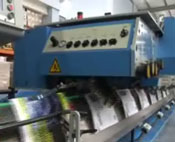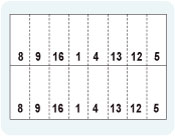 Saddle-stitched books can be produced in endless sizes and page counts which means you have hundreds of ways to fold the signatures that make up the book. The reality is that most shops use just a handful of standard impositions. These get filtered down by book size, page count, press size, folding machine capability and saddle stitcher capability, whether in-house or outsourced.
Saddle-stitched books can be produced in endless sizes and page counts which means you have hundreds of ways to fold the signatures that make up the book. The reality is that most shops use just a handful of standard impositions. These get filtered down by book size, page count, press size, folding machine capability and saddle stitcher capability, whether in-house or outsourced.
In my commercial printing bindery experience most of the books we produced were the usual 8.5 x 11 or 5.5 x 8.5”. Perhaps your primary jobs are pamphlet size 4 x 9” or similar. Whatever our specialty, we get lulled into a routine for producing a certain type of work and a few impositions become habit. Where we can lose out is on the occasion a book is outside our normal routine.
In our case, we’d get the occasional 4x9” or other odd sized book (odd for us) that was outside our routine. More often than not, it would receive the same type of imposition as the larger ‘normal’ books. It might have been sent to us that way, or the prep department could have just laid it out that way without asking. Our normal 16 page signatures would be folded 1x in the main section, 1x in the 8pp right angle and 1x in the 16-page right angle.
 As you get to the smaller books however, your options expand. Take the 4 x 9 book for example. You could also lay it out as a parallel 16 page signature as shown in the drawing. (Trims not shown.) It takes up about the same space on the sheet as the ‘normal’ imposition but there are several big advantages to running it this way.
As you get to the smaller books however, your options expand. Take the 4 x 9 book for example. You could also lay it out as a parallel 16 page signature as shown in the drawing. (Trims not shown.) It takes up about the same space on the sheet as the ‘normal’ imposition but there are several big advantages to running it this way.
- It can be run 2-up on the folder for a dramatically higher hourly yield. With a 34.5” long signature as imposed here, it’s relatively easy to net 10-15,000 (or more) 16 page signatures hourly in a 2-up parallel fashion. It’s not nearly so easy to net that on a right-angle cross-carrier folder running a 1-up 16 page right-angle signature.
- Crossover registration (a.k.a. lineup) is improved, especially if they’re numerous. Controlling crossovers in right-angle 16 page signatures requires far more monitoring and adjusting than with a parallel 16. The parallel is about as close to a set-and-forget folding job as you can get, given of course, that press registration and guillotine cutting are up to snuff.
- Higher average running speeds. A 16 page signature as shown is 3 parallel folds accomplished in the first section only, so you’re not limited by the slower speeds typically imposed by right-angle cross carriers. Even though the parallel 16 is a longer sheet than the right angle 16, you can usually match or exceed sheets/hour of the smaller right-angle sheet. (Granted, knife folders will run faster than cross-carrier type folders.) In any event, doing 3 folds in one section means far fewer variables to contend with as well as fewer machine stoppages than with the right-angle folds. This translates to high speed continuous production plus quality that is easier to achieve. A novice folder operator who easily sets up a parallel fold signature may struggle with a right-angle 16 page sig.
- Save paper. Depending on the book size and page count, parallel folded signatures might let you get more out of a sheet. There are dozens of impositions to choose from, so don't limit yourself to the parallel folds shown here. It’s definitely worth a look on longer runs.
The bottom line: when something different comes in the door and you’re faced with an atypical job, dust off your memory or pull out an imposition book and do a little figuring. You just might be able to boost production and quality while making your folder operator's life easier.
We welcome your comments and suggestions below.

